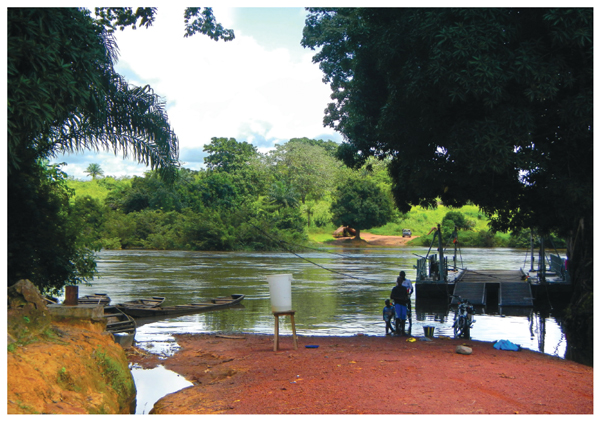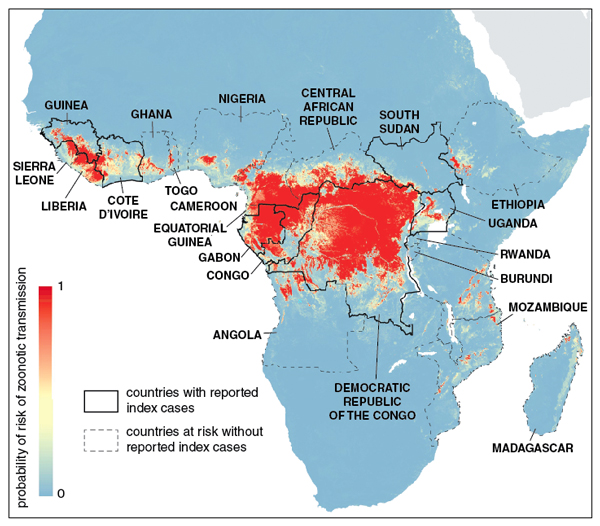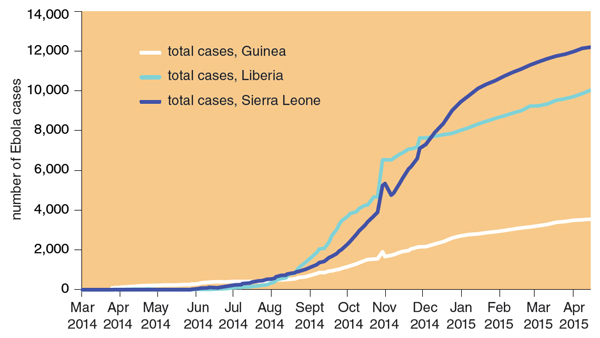Breached Ecological Barriers and the Ebola Outbreak
By Robert Dorit
The epidemic may be waning, but the social and ecological context that brought it about remains.
The epidemic may be waning, but the social and ecological context that brought it about remains.

DOI: 10.1511/2015.115.256
On Christmas Day 2013, two-year-old Emile Ouamouno fell ill in the small village of Méliandou in Guinea. In the weeks leading up to his illness, he and his friends had been playing in the outskirts of the village, sometimes around a hollowed-out tree. What Emile and the rest of the world could not suspect was that this pastoral childhood scene would mark the beginning of the largest Ebola outbreak ever seen. That tree was the roosting habitat for thousands of bats, including the widespread, mouse-sized Angolan free-tailed bat. Young Emile unwittingly served as the bridge between a well-established reservoir of Ebola and the human population.
Six days later, Emile died. In the 15 months that followed, this lethal outbreak created outright panic in many places. The world has witnessed 22 Ebola outbreaks since 1975, but nothing had come near to this latest episode: The closest in severity occurred in 1995 in Zaire, where 315 people were diagnosed and 254 died. In contrast, the current outbreak, as of May 3, has already infected 26,593 patients and claimed the lives of 11,005. Although there are encouraging signs that the threat of further spread may be waning, the epidemic is not yet over. Weekly counts of new cases have shown decline before, only to be followed by subsequent increases. This outbreak will not be truly over, according to standard quarantine statistics, until no new cases are reported for five consecutive weeks.
It is vexingly hard to determine what made this Ebola epidemic so much worse than previous episodes: Biology, economics, culture, politics, and chance all play a part in the trajectory of an emerging infection. Previous outbreaks had devastated communities, but those episodes had also been self-limiting and geographically contained within a single or small group of villages.

Image courtesy of the Centers for Disease Control Public Health Image Library.
This time, things were different. By the end of January 2014, several members of Emile’s family were infected and died; by February, caregivers and those who had attended funerals of Ebola victims spread the outbreak 50 miles from Méliandou. By mid-March, cases were reported more than 100 miles from the hollow tree where Emile had played.
Geographical circumstances only made matters worse. The virus had slipped into the human population in a village not far from the border between three countries: Guinea, Sierra Leone, and Liberia. Because these are three of the poorest countries in the world and because two of them are just emerging from years of internal strife, the dispersal of the virus was accelerated.
The severity of this Ebola episode is not driven solely by molecular mechanisms but is also a consequence of changing ecology. This outbreak encompasses more than the tragic deaths of a toddler and tens of thousands who later contracted the illness. How Emile and the infected bat encountered one another in the first place, and how modern-day movements of impoverished people facilitated the spread of Ebola far beyond Méliandou, are the telling consequences of disrupted ecologies.
The village of Méliandou, once surrounded by lush tropical forests, was now in the midst of a denuded landscape. Despite its recognized importance as a global biodiversity hotspot, the West African Guinea Rainforest has shrunk to 18 percent of its original size, and Guinea, Emile’s home country, has been losing roughly 1 percent of its forest every year for the past three decades. The deforestation near Méliandou was, if anything, even more dramatic, as more than 80 percent of the forested areas were cleared to make way for oil palm and fruit tree plantations.
These should have been ominous warnings: Many if not all of the previous outbreaks of Ebola had occurred in areas of recent extensive deforestation. The changing landscape also impacted daily routines. In search of work and opportunity, and later in search of clinics, people traveled increasingly far from their villages. At the start of 2014, it was weeks before the mounting case count attracted the notice of national health authorities and longer still before the virus had been identified.
Unlike the influenza virus, which emerges seasonally within the human population only to recede into the background until the next flu season, the Ebola virus had not been smoldering undetected in the human population. Instead, it was concealed, possibly in one or more bat species. Like all viruses, Ebola is incapable of independent living; its evolutionary strategy consists of tricking a host into doing most of its molecular bidding. The consequences of harboring the Ebola virus, however, depend on the identity of the host. The fruit bats that act as the primary residence for it suffer few, if any, ill effects: They appear to have reached an evolutionary accommodation with the virus. Anywhere from 10 to 40 percent of fruit bats examined in the field show evidence of prior exposure to Ebola and are able to mount a successful immune response to the virus.
To understand what happened in West Africa, the medical community needs to bring an ecological perspective to our analysis of infectious disease. This outbreak is in part a story of breached boundaries—between bats and people, between Méliandou and the forest that surrounded it, and between an intact forest and the fragmented landscape it had become. When the Ebola virus breaks out of its natural reservoir and into a new mammalian host, it leaves destruction in its wake. People are now keenly aware of its effects on the human population, but other animals have also suffered: Close to 5,000 gorillas died in an Ebola epidemic in the Congo in 2002 and 2003. Primates are not the virus’s normal reservoir and so pay dearly for a lack of evolutionary familiarity.
Unlike the immune systems of bats, which hold the virus in check, ours betray us. The virus targets the very cells meant to sound the alarm when a foreign invader enters our body. Ebola silences these cells and hijacks their machinery, making copies of itself and lulling a hypervigilant immune system into thinking nothing is amiss. Only after multiple rounds of viral replication do the infected host cells manage to send out a chemical alarm in the form of cytokine molecules—and when they do so, it causes havoc. The body overreacts: Blood vessels and organs lose their integrity, and death often results. Because Ebola kills by turning the body against itself, even the age brackets that are normally spared the worst consequences of infectious disease—the young and healthy—fall prey: 57 percent of the Ebola cases in the ongoing outbreak occurred in patients aged 15 to 45.
The history and cultural practices of the region mattered far more than national borders: People traveled to and fro according to a carefully prescribed set of social engagements. Many of the human movements that enabled the initial outbreak reflected established family and commercial ties within the Kissi-speaking peoples of the area, setting the stage for the early phases of the epidemic.
Even the most fundamental of boundaries, the one separating the living from the dead, would not be respected during this outbreak. Although the overwhelming majority of viruses require a live host to ensure transmission, Ebola is an exception. Bodies of victims remain infectious for up to seven days after death, transforming a central human ritual into a dangerous transmission route. As a result, many of the initial victims of this outbreak were either healthcare workers involved in the treatment of patients up to the moment of their death or family members and social relations involved in preparing the bodies for burial. This particularly macabre dimension of the epidemic greatly complicated the global response.
In the globalized reality of the 21st century, geographic distances mean much less than they once did. Every emergent infectious disease has the potential to spread widely and quickly. An effective response will certainly depend on our ability to anticipate new outbreaks. This is no simple task—chance and contingency always play a role. But until the ecological dimensions of infectious disease are fully acknowledged, predictions will be no more than guesses. Ebola did not emerge in a vacuum, but in the midst of human-made ecological disturbance.
For a short time last century, we biologists were almost convinced that infectious diseases were a thing of the past. In the mid-1960s and even into the 1970s, improvements in sanitation, the success of vaccination programs, and the startling efficacy of antibiotics all seemed to foreshadow a time when humanity no longer needed to worry about infectious disease.
In fairness, mortality and morbidity resulting from infectious disease did appear to be declining dramatically, particularly in the years following World War II. That trend, extrapolated into the future, hinted at victory. But the extrapolation and the optimism it engendered were premature. Even then, antibiotic-resistant bacterial strains were emerging as a clinical concern. And in the early 1980s, a previously uncharacterized virus, HIV, burst onto the scene, marking the start of the most devastating epidemic since the 1918 influenza pandemic. HIV, too, had repeatedly moved from its nonhuman primate reservoir into the human population in areas marked by population growth and environmental degradation. Soon, propelled by the movement of people driven by economic dislocation, the HIV epidemic reshaped the world. The age of innocence was over, replaced by a new age, one in which infectious disease was revealed to be an inescapable fact of life.
Public health and environmental stewardship are not separate issues.
The forecasts are not reassuring. Biologists know, for instance, that the rate of discovery of new and potentially threatening human viruses has remained virtually unchanged over the past 60 years and shows no signs of slowing down. We can expect that between 10 and 40 new viral species will be discovered before the end of the decade. A similar picture emerges from more complex models that incorporate the effect of an expanding human population. Even after controlling for the effects of increased surveillance, emergent infections are increasing in frequency.

Figure from Pigott, et al. 2014.
The trend is exacerbated by the increased density of domesticated animals, many of which act as intermediate conduits for the movement of viruses into the human population. The connection between the economics of large-scale meat production and the emergence of new infectious diseases may not seem obvious. But these unexpected consequences underscore the importance of framing emerging infectious diseases in an ecological context. The ecological disturbances that drive the movement of hosts, vectors, and reservoirs are not incidental to our understanding of the dynamics of disease. They are central to it.
Every outbreak is unique, and this Ebola epidemic is no exception. A set of time- and place-specific circumstances allowed the virus to gain a toehold in the human population, and a series of miscalculations by local and international authorities led to its rapid spread. Without wishing to downplay the specific circumstances of this epidemic, I argue that this, along with virtually every other infectious disease outbreak of the past three decades, reflects our increasingly dysfunctional relationship to the rest of the living world.
Let me be clear: Pathogens always have been as much a part of the fabric of life as we are. Within an ecosystem, the numbers of pathogens and their impacts are self-limiting: Most viruses, for instance, abide at low densities in their zoonotic reservoir—the animal host they commonly infect without causing any obvious illness. But an ecological perspective sheds new light on emergent infectious diseases: Pathogens do not swarm into the human population because they suddenly become virulent—rather, we breach the boundaries that contain them.
New pathogens have myriad opportunities to break through the walls that separate us from them. Fortunately, most of these incursions are unsuccessful. Most pathogens specialize on their host and cannot readily cross the phylogenetic distance separating us from their zoonotic home. While cross-species transfers of pathogens occur all the time, most are dead ends—the virus never gains a foothold in the novel population. Epidemiologists’ estimates of the number of emergent infections are likely significant underestimates, because we are unaware of many failed attempts to breach the species barrier.

Data from the US Centers for Disease Control and Prevention, http://1.usa.gov/1J8QT75.
The inexorable rise in emerging infections is, like climate change and extinction, another dire reminder of our clumsy footprint on the biosphere. Nearly two-thirds of emergent infections over the past 50 years have zoonotic origins, and most of those have come from a wildlife reservoir (as opposed to a domesticated animal). We have significantly diminished wildlife habitats, forcing animals—and their pathogens—to live in close proximity to us. The relentless deforestation taking place around Méliandou set the stage for Emile’s fateful encounter with an infected bat.
Transgressing pathogens take advantage of ecological disruption and ecosystem instability to enter into territory that would otherwise be closed to them. Now, the very boundaries that kept many pathogens in their reservoirs are increasingly frayed. Deforestation and agriculture in marginally arable lands bring people in closer contact with wildlife populations. Often, the people of these liminal areas are in poor health and may travel far in search of meat to supplement meager diets. As the numbers of encounters between humans and wildlife increase, so does the possibility of cross-species transmission. Even though the chances of a virus surviving in a new host are vanishingly small, the number of contacts render the improbable virtually inevitable.
In this sense, pathogens have become invasive species. As with all such species, the loss of endemic biodiversity itself contributes directly to the invasion. As the diversity of species that could serve as alternative hosts declines, only the vulnerable human population and its domesticated animals are left as the targets of zoonotic invasion. The overall claim that biodiversity loss is a risk factor is referred to as the dilution effect model, and it seems to fit the data for some diseases, such as hantaviruses and Ebola.
Even emerging infections that are not zoonotic can be viewed as invasive. Over the past three decades, a full fifth of emerging infections can be traced to antibiotic-resistant bacterial invasions of the body, often in hospitals or other care settings. Antibiotic abuse decimates commensal gut flora and sets the stage for pathogen invasion. Broad-spectrum antibiotics disrupt the ecology of the microbiome; logging disrupts the ecology of the forest. These two disturbances occur at dramatically different scales, yet share a deep connection. A disrupted ecosystem is vulnerable, and emerging diseases are an almost inevitable consequence.
This recent Ebola outbreak highlighted deep structural weaknesses in our ability to detect and respond to epidemics. Weeks elapsed before anything resembling an organized response emerged, and by then, hundreds of people had come into contact with infected individuals. We can do better, but only if we acknowledge that we have created the conditions for the constant emergence of new infectious threats. To be sure, diagnostic tools, computational resources, and modeling abilities have improved dramatically, particularly over the past 15 years. Some of these improvements were evident in the response to this Ebola crisis: Viral genomes from some of the very first patients were fully sequenced and analyzed within weeks, a feat that would have been impossible even five years ago.
As I write this, the acute phase of the outbreak appears to be over: Only 35 new cases have emerged in the last week. The world has exhaled, relieved that the dire predictions of more than a million cases have not come to pass, and attention has shifted to other disasters. The affected countries have begun the long process of rebuilding communities and economies. But the Ebola virus has not simply vanished from the face of the Earth. It still lurks in wildlife populations, and may be hiding in the seminal and ocular fluids of infected individuals.
This outbreak made it plain that political boundaries, ethnic divisions, and historical grievances are of little consequence to infectious diseases. Nor does distance matter as it once did: Today, infections can spread around the world in a matter of days. Detection and response to emerging infections need to be quicker and more agile. Perhaps most important, we need to recognize that infectious diseases are not simply medical emergencies but ecological phenomena. Public health and environmental stewardship are not separate issues. They are inextricably linked.
Click "American Scientist" to access home page
American Scientist Comments and Discussion
To discuss our articles or comment on them, please share them and tag American Scientist on social media platforms. Here are links to our profiles on Twitter, Facebook, and LinkedIn.
If we re-share your post, we will moderate comments/discussion following our comments policy.